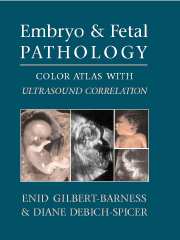Book contents
- Frontmatter
- Contents
- Foreword by John M. Opitz
- Preface
- Acknowledgments
- 1 The Human Embryo and Embryonic Growth Disorganization
- 2 Late Fetal Death, Stillbirth, and Neonatal Death
- 3 Fetal Autopsy
- 4 Ultrasound of Embryo and Fetus: General Principles
- 5 Abnormalities of Placenta
- 6 Chromosomal Abnormalities in the Embryo and Fetus
- 7 Terminology of Errors of Morphogenesis
- 8 Malformation Syndromes
- 9 Dysplasias
- 10 Disruptions and Amnion Rupture Sequence
- 11 Intrauterine Growth Retardation
- 12 Fetal Hydrops and Cystic Hygroma
- 13 Central Nervous System Defects
- 14 Craniofacial Defects
- 15 Skeletal Abnormalities
- 16 Cardiovascular System Defects
- 17 Respiratory System
- 18 Gastrointestinal Tract and Liver
- 19 Genito-Urinary System
- 20 Congenital Tumors
- 21 Fetal and Neonatal Skin Disorders
- 22 Intrauterine Infection
- 23 Multiple Gestations and Conjoined Twins
- 24 Metabolic Diseases
- Appendices
- Index
20 - Congenital Tumors
Published online by Cambridge University Press: 23 February 2010
- Frontmatter
- Contents
- Foreword by John M. Opitz
- Preface
- Acknowledgments
- 1 The Human Embryo and Embryonic Growth Disorganization
- 2 Late Fetal Death, Stillbirth, and Neonatal Death
- 3 Fetal Autopsy
- 4 Ultrasound of Embryo and Fetus: General Principles
- 5 Abnormalities of Placenta
- 6 Chromosomal Abnormalities in the Embryo and Fetus
- 7 Terminology of Errors of Morphogenesis
- 8 Malformation Syndromes
- 9 Dysplasias
- 10 Disruptions and Amnion Rupture Sequence
- 11 Intrauterine Growth Retardation
- 12 Fetal Hydrops and Cystic Hygroma
- 13 Central Nervous System Defects
- 14 Craniofacial Defects
- 15 Skeletal Abnormalities
- 16 Cardiovascular System Defects
- 17 Respiratory System
- 18 Gastrointestinal Tract and Liver
- 19 Genito-Urinary System
- 20 Congenital Tumors
- 21 Fetal and Neonatal Skin Disorders
- 22 Intrauterine Infection
- 23 Multiple Gestations and Conjoined Twins
- 24 Metabolic Diseases
- Appendices
- Index
Summary
Congenital tumors are often composed of persistent embryonal or fetal tissues, suggesting a failure of proper cytodifferentiation or maturation during early life. Neuroblastoma develops from neural crest cells that migrate into the gland during embryonic and fetal life. Normally, these cells mature to ganglion cells.
Morphologic features of embryonic neoplasms include retinoblastoma, peripheral primitive neuroectodermal tumor (PNET), hepatoblastoma, yolk sac tumor of the testis, and embryonal rhabdomyosarcoma. Some teratomas show proliferation ofembryonic tissues that fail tomature. Anumberof tumors in the young are associated with congenital malformations and growth disturbances.
Some embryonic tumors have a benign course despite a malignant microscopic appearance such as stage IV-S neuroblastoma, congenital fibrosarcoma, and nephroblastomatosis. These tumors may undergo cytodifferentiation and spontaneous regression. Malignant neoplasms are seldom seen in the newborn and only infrequently are responsible for neonatal death or spontaneous abortion. Chromosomal abnormalities associated with childhood tumors are shown in Table 20.1.
VASCULAR TUMORS
Hemangiomas are the most common tumors of the skin and soft tissues in infants (Figure 20.1).
Benign Hemangiomas
Capillary hemangioma usually manifests at birth, grows steadily for 68 months, then stabilizes, and eventually regresses, although complete disappearance may take several years. It is composed of capillaries separated by stroma. It may present as a raised subcutaneous nodule that blanches under pressure. Because childhood hemangiomas are tumors that evolve in time, a capillary hemangioma is thought to originate from a more primitive form.
- Type
- Chapter
- Information
- Embryo and Fetal PathologyColor Atlas with Ultrasound Correlation, pp. 546 - 578Publisher: Cambridge University PressPrint publication year: 2004

